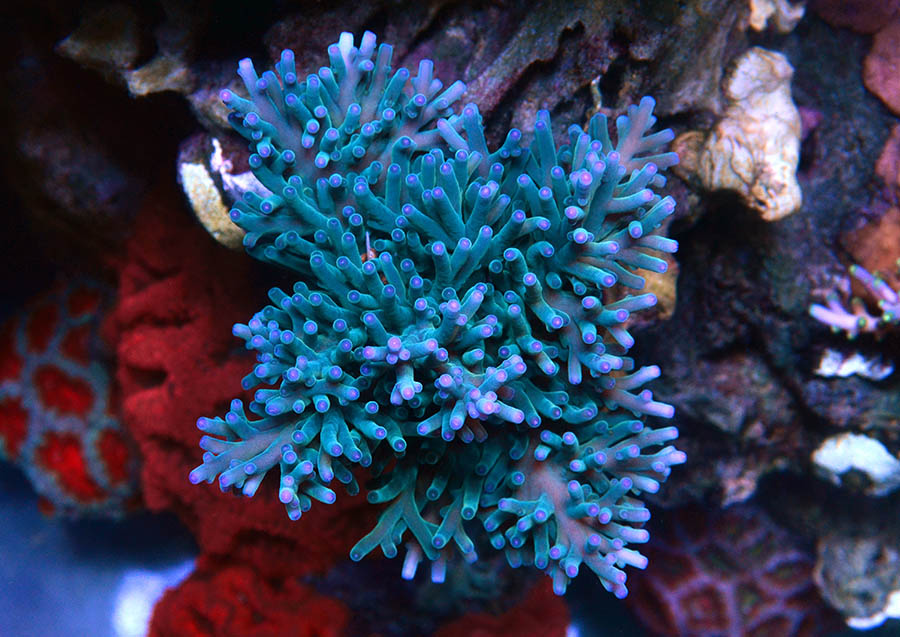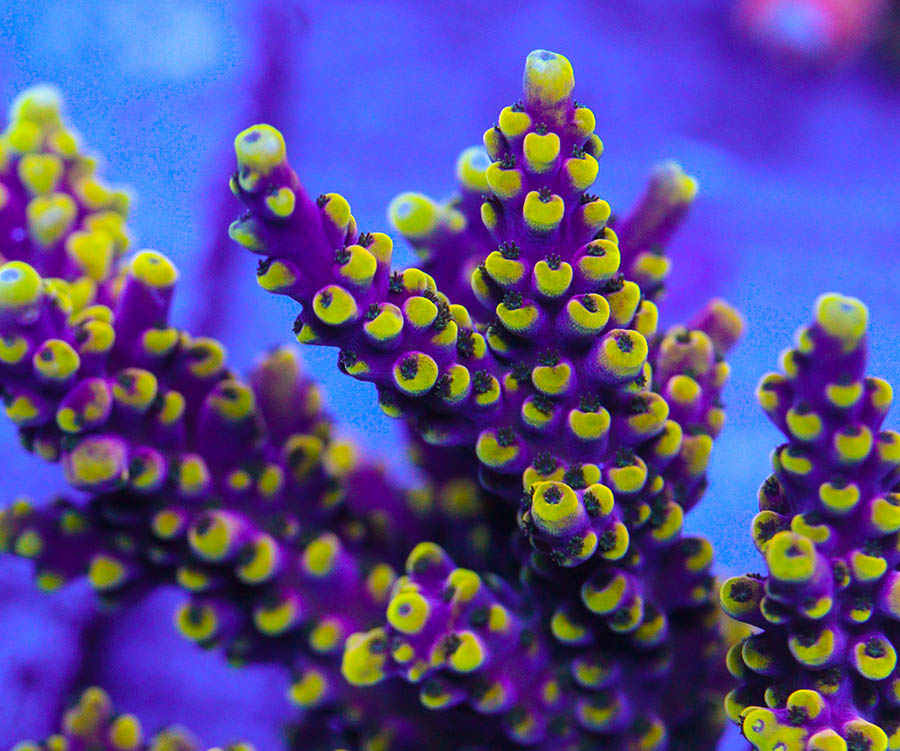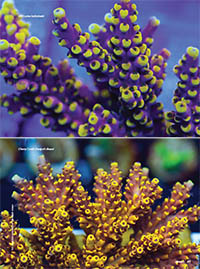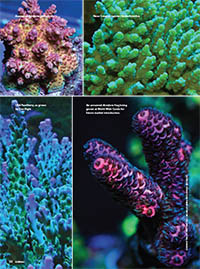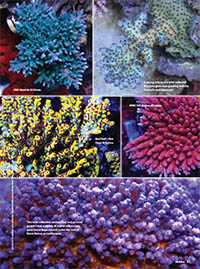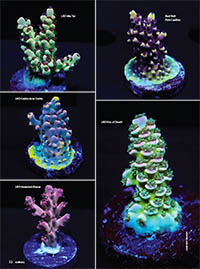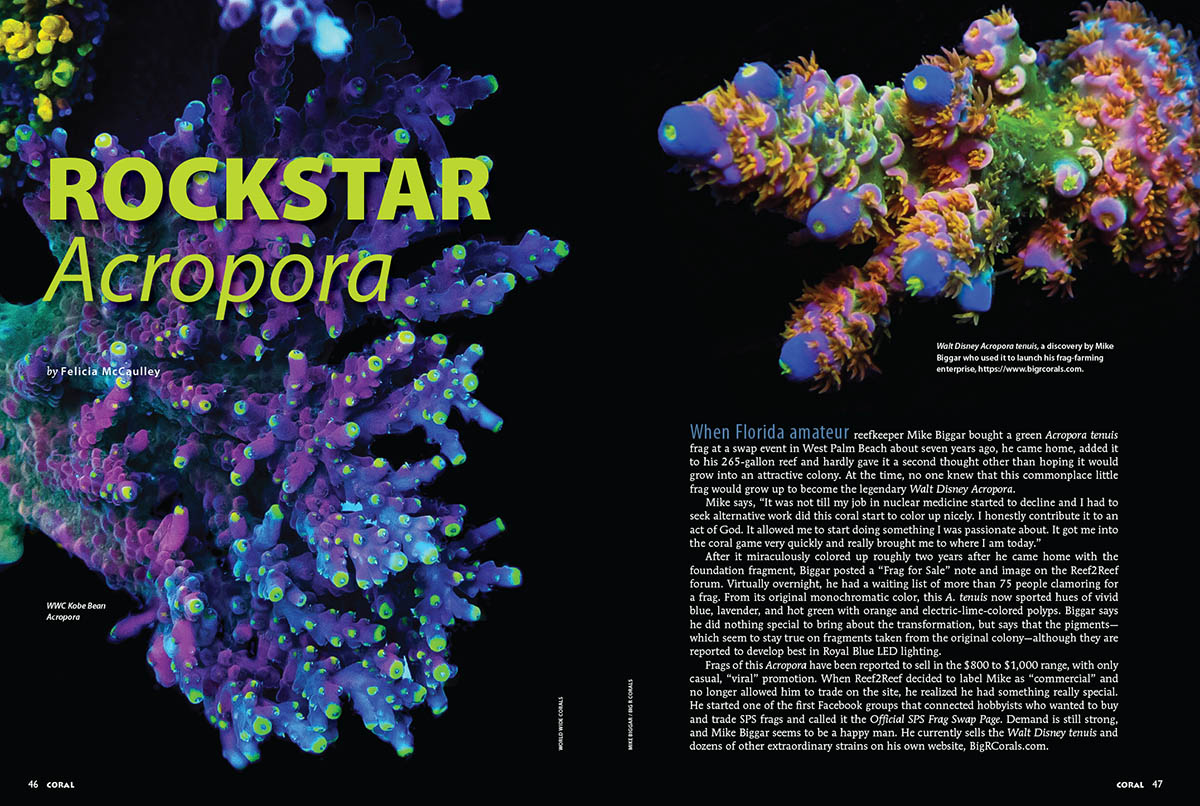
Rockstar Acropora, by Felicia McCaulley, as published in the November/December 2018 issue of CORAL Magazine.
When Florida amateur reefkeeper Mike Biggar bought a green Acropora tenuis frag at a swap event in West Palm Beach about seven years ago, he came home, added it to his 265-gallon reef and hardly gave it a second thought other than hoping it would grow into an attractive colony. At the time, no one knew that this commonplace little frag would grow up to become the legendary Walt Disney Acropora.

Readers of this article in the November/December 2018 issue of CORAL get to experience a lavish pictorial of stunning Acropora cultivars. Don’t miss out: dlick to order this back issue for your collection.
Mike says, “It was not till my job in nuclear medicine started to decline and I had to seek alternative work did this coral start to color up nicely. I honestly contribute it to an act of God. It allowed me to start doing something I was passionate about. It got me into the coral game very quickly and really brought me to where I am today.”
After it miraculously colored up roughly two years after he came home with the foundation fragment, Biggar posted a “Frag for Sale” note and image on the Reef2Reef forum. Virtually overnight, he had a waiting list of more than 75 people clamoring for a frag. From its original monochromatic color, this A. tenuis now sported hues of vivid blue, lavender, and hot green with orange and electric-lime-colored polyps. Biggar says he did nothing special to bring about the transformation but says that the pigments seem to stay true on fragments taken from the original colony, although they are reported to develop best in Royal Blue LED lighting.
Frags of this Acropora have been reported to sell in the $800 to $1,000 range, with only casual, “viral” promotion. When Reef2Reef decided to label Mike as “commercial” and no longer allowed him to trade on the site, he realized he had something really special. He started one of the first Facebook groups that connected hobbyists who wanted to buy and trade SPS frags and called it the Offi cial SPS Frag Swap Page. Demand is still strong, and Mike Biggar seems to be a happy man. He currently sells the Walt Disney tenuis and dozens of other extraordinary strains on his own website, BigRCorals.com.
The Lure of Acropora
The multitude of species grouped in the family Acroporidae are more variable in shape and color than any other taxonomic gathering of stony corals. The delicate branches of the bottlebrush Acropora echinata could not be more different from the massive, flattened antlers of the Caribbean Elkhorn, A. palmata, or the large, plating Efflo Acro, A. efflorescens, which is so flat it is sometimes mistaken for a Montipora.
Never before have aquarists had so many Acropora species and color morphs to choose among, and it could be said that we are entering a Golden Age of Acropora Culture. The choices are mindboggling: coveted, sustainably collected Australian Acropora “baby” table colonies, spindly-branched and delicately hued deepwater Acropora, and shockingly vivid maricultured and tank-farmed Acropora frags have never been more in demand. Acropora with intense multicolor, blue, pink, red, golden or orange coloration commanding the highest prices. Blue bottlebrush A. echinata, pink or orange A. millepora, and Red Dragon A. carduus are some more popular wild-collected and maricultured premium Acropora collectors and farmers seek from the growing number of “rockstar” frag farmers, as well as from local aquarium shops featuring premium frags or from direct livestock sources such as LiveAquaria’s Diver’s Den, Unique Corals, World Wide Corals, and others.
Many reefers today prefer to buy or barter for captive- grown frags and maricultured corals rather than wild colonies. Captive-grown frags tend to be more colorful and are more likely to acclimate to a new aquarium and thrive in captivity. Wild colonies offer expert reefkeepers new strains to domesticate.
Oceans, Reefs & Aquariums still cultures their classic must-have Acropora for collectors—the ORA Red Planet and the ORA Pearlberry. Other new strains from smaller frag farmers are so amazingly, unexpectedly colored that some incredulous hobbyists who saw photos of Jason Fox’s Homewrecker suspected that the photos were manipulated, but those of us who saw the frags in real life at MACNA in New Orleans agreed that the photos were true to life. One hobbyist who witnessed the Jason Fox Homewrecker frags there in person, Paul Poeschl said, “You can’t Photoshop real life.”
We have started a series of talks with Acropora farmers about their favorite Acropora corals and how they have been successful, to start here and be continued in future issues of CORAL.
Ann Paden of Living Reef Orlando
Ann Paden, Lead Photographer of Living Reef Orlando, has been in the hobby for about 8 years. She says, “Living Reef Orlando was established in 2013 and is a premier fish store located in Central Florida. We specialize in the preservation of all things aquatics and strive to maintain the utmost health of all our fish, corals and inverts. Although we maintain a wide variety of corals in our farms, stony corals are our specialty. We put our Acropora through an extensive 12-week quarantine process where they receive dips and bases get cut off before they finally reside in a grow-out system in our farm. Good lighting, heavy flow and a special mix of aminos and coral foods are what help us to keep our Acroporas thriving.”
Many of their famous pedigreed Acropora corals had humble beginnings as small, insignificantly colored frags or small colonies that had obvious potential. Ann’s personal favorite is the LRO Bonita Applebum.
Thinh Vu of MyticalCorals.com
Thinh Vu became interested in fish at a very early age where he grew up in Vietnam where Bettas are so popular. A friend introduced him to reefing about 12 years ago, and he has been hooked ever since.
Vu works in aviation fabricating metal for airplanes, jets, and helicopters. He used to only sell and trade his amazing frags locally, but with the encouragement of his good friend photographer Michael Vargas, he started a presence on Facebook, joined reefing communities, and eventually developed his website MythicalCorals.com.
Vu has some impressive Acropora colonies in his surprisingly simple 260-gallon reef system. He uses a combination of ATI T5 and Reefbrite LEDs to light his tank. A dosing pump maintains calcium, alkalinity, and magnesium. His Acropora thrive in the high flow provided by his EcoTech MP40. He employs both an algae scrubber and a refugium to export nutrients and a chiller to control the temperature. He says that he has learned that Acropora corals are particularly sensitive to high-temperature spikes, which can cause bleaching.
Some of his favorite Acroporas are his incredible Jason Fox Homewrecker colony, Reef Raft Jawdropper, and Reef Raft Bleeding Avenger. Even with all of his experience, he is still learning every day and cherishes the friendships he makes with other hobbyists and the knowledge they share with the community.
With practice and experience, almost any reefer the desire can become an Acropora farmer. All it takes is perseverance when inevitable setbacks are experienced and a keen eye for corals with the potential for exceptional coloring and shape.
CORAL Magazine FragFinder
Here is a link to a number of sources of Acropora fragments recommended by CORAL contributors.
https://www.coralmagazine.com/fragfinder
SUGGESTIONS?
To suggest additions to the FragFinder list, or to share your own Acropora keeping experiences and images, visit this page:
http://www.coralmagazine.com/share-your-acropora-experiences
DON’T MISS OUT!
There is so much more in the print & digital edition of this article. Subscribe today and find out what all these gorgeous corals are!
